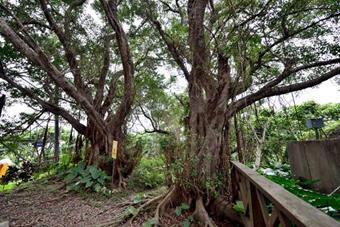榕樹 Chinese Banyan trees (Rongshu)
榕樹的樹幹粗壯、樹皮光滑,有氣根從莖上垂下來,可用來幫助呼吸。榕樹生長快速且繁殖容易,榕樹對空氣汙染的抵抗力很強,常作為防風林、盆栽、行道樹或庭園美化用。 且榕樹有一特殊現象:纏勒現象,又稱絞殺,常見於熱帶雨林;臺灣地處副熱帶氣候區,天氣濕熱,纏勒現象也常見。纏勒植物的種子因為某些原因(如鳥類的排泄物、風吹、水流等因素),落在另一棵植物上,在適當的環境下種子開始成長,並向下不斷延伸氣根,吸收水分及養分。纏勒植物生長快速枝葉茂密,最後把原植物整個包圍起來,被纏勒的植物因四周受限不利生長而枯死。 Chinese Banyan trees (Rongshu) have thick trunks, smooth bark, and aerial roots hanging down that help them to breathe. They grow quickly and breed easily, and since they have good resistance against air pollution, they are often used in windbreak forests and as bonsai, shade trees, and garden plants. Banyan trees exhibit a special phenomenon called "strangling," which is commonly seen in tropical rainforests. Taiwan is in the subtropical climate zone, where the weather is hot and humid, and where strangling is common as well. When the seed of a strangling plant falls on another plant due to bird droppings, wind, water, etc., and the environment is suitable, the seed starts to group and the aerial roots start to grow downward to absorb water and nutrients. These plants grow fast, and also have dense branch and leaf networks; the original plant is soon surrounded, and eventually withers.
